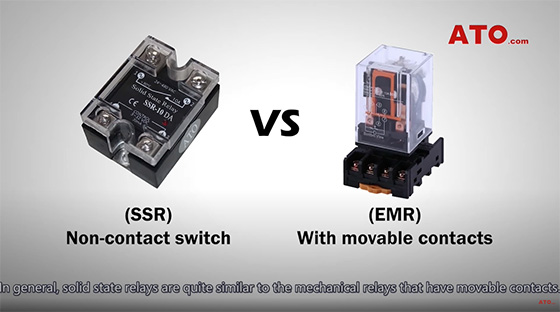Solid State Relay vs. Mechanical Relay
In general, solid state relays are quite similar to the mechanical relays that have movable contacts. The main difference between both is the fact that there are no actual moving components in an SSR, just like the name suggests. Rather than relying on a physical contact moving to complete the circuit, solid state relays (SSR) employ optical semiconductor switching elements, such as diodes, thyristors, triacs and transistors.
In this article, ATO automation will explore these two typical relays and find out more about their differences.

Functions and Advantages:
The basic parts and functions of mechanical relays include the coil, armature, and contacts. In these relays, electromechanical force is generated by the relay coil on the application of voltage. This force pulls the armature and closes the relay contacts. An attached spring returns the armature to its original position. The contacts are the conducting parts of the switch that makes (closes) or breaks (opens) a circuit. When the contacts make a connection there is typically a "click" sound, which can be useful in some situations, though it can lead to internal arcing.
SSRs do not have electromagnet or any moving contacts in it. Instead, it consists of an input circuit, an optocoupler, output driver circuits, and semiconductor switching devices. When a voltage is applied to the input section of the industrial solid state relay, current flows through the optocoupler and triggers the semiconductor switch at the output section, and the switch starts conducting. SSR relays have slowly overtaken EMRs as the most popular option thanks to their ease of use, low noise production, extra safety features, and long life span. The main downside of high performance solid state relays is that they produce a lot of heat and require heat sinks. Therefore heat sinks are required for heat dissipation. While EMRs produce less heat than SSRs, they're noisy, erode during prolonged switching, can cause arc formations and voltage surges, and have a much shorter lifespan than SSRs, factors that ultimately make them the less versatile and less popular option.
In addition, solid state relays often outperform mechanical relays in several areas. Let's compare the two:
| Relay | Solid State Relay | Mechanical Relay |
| Power Consumption | 1.Feature low power consumption 2.Require little input power for switching loads 3.High heat generation |
1.Require higher input power to operate 2.The power consumption depends upon the switching voltage and resistance of the contacts. |
| Positional Sensitivity | 1.Are positional insensitive 2.Are suitable for mounting in vertical or horizontal positions, "dead bug" position or adjacent mounting |
1.Mechanical system is subject to external forces 2.External forces must be perpendicular to relay action |
| Switching Performance | Respond to control signals in less 100μs. | Responds to control signals in around 5 to 15 ms (about 100 times slower than an SSR). |
Application:
Solid state relays can be used for: high speed and frequent switching operations; high vibration environments; where the relay has to be located near sensitive automation components, such as PLC's, HMIs, and temperature controllers; dusty or humid environments; hazardous locations (presence of fumes or gases).
Mechanical relays can be used for a wide output range from the relay; motors & transformers requiring high starting amps; where the initial installation budget is very limited; prone to current surges and voltage spikes.
If you want to know more about solid state relay, please click the following video.

